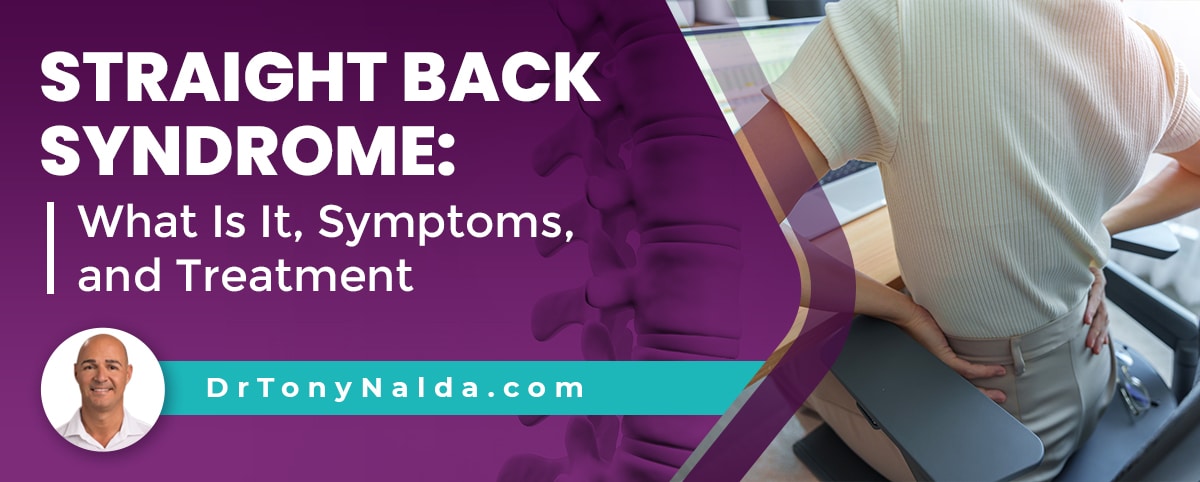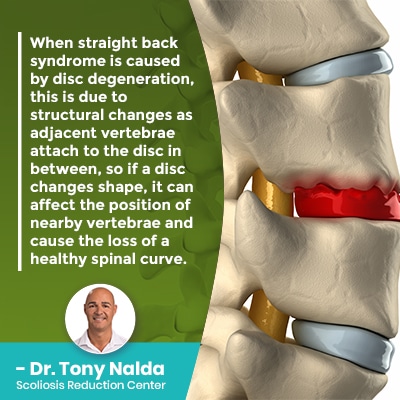Straight Back Syndrome: What Is It, Symptoms, and Treatment

The spine is a complex structure with many moving parts; its natural and healthy spinal curves, that give it its characteristic 'S' shape, help keep the spine aligned so it can function optimally. When straight back syndrome is diagnosed, a loss of thoracic spine kyphosis and/or lordosis has made the spine unnaturally straight, disrupting its biomechanics.
The spine's natural curves are key to its overall health and function, and when the thoracic spine loses its natural kyphosis, becoming excessively straight, this is known as straight back syndrome; symptoms and treatment needs are case-specific.
Table of Contents
What is Straight Back Syndrome?
The spine is naturally curved, and when the size of these curves fall within a healthy range, it can function as it's supposed to, but when the spine loses one or more of its healthy curves, problems occur.
The spine is made up of three main sections known as the cervical spine (neck), thoracic spine (middle/upper back), and lumbar spine (lower back).
Each spinal section has a characteristic curvature type, and the health of each depends on the health of the other spinal curves.
When the spine is naturally curved, as it was designed to be, it's flexible, strong, and can absorb/distribute mechanical stress incurred during movement, but what happens when its natural curves become unnatural curves?
Understanding the effects of unnatural spinal curves is based on an understanding of its natural curves, so let's move on to the spine's curvature types: lordosis and kyphosis.
Lordosis and Kyphosis
Lordosis and kyphosis are terms referencing the spine's curvatures that either bend inwards, or outwards.
Lordotic curves are those that bend inwards, towards the body's center, and the spine's kyphotic curve is one that bends outwards, away from the center of the body; the cervical and lumbar spinal sections feature lordotic curves, while the upper thoracic spine has a kyphotic curve.
From person to person, the degrees of kyphosis and lordosis will vary as there is a healthy range of curvature sizes, but if a person's degree of upper thoracic spine kyphosis and/or lordosis falls beyond a typical range, a number of spinal issues/conditions can be the cause.
When the spine loses its normal kyphosis in the thoracic spine and/or lordosis in other spinal sections, it can become unnaturally straight: straight back syndrome (sbs), aka straight spine syndrome.
Causes of Straight Back Syndrome
 There are different causes for the development of straight back syndrome, some of the most common being congenital spinal malformation, spinal conditions such as ankylosing spondylitis, osteoporosis, degenerative disc disease, and spinal surgery.
There are different causes for the development of straight back syndrome, some of the most common being congenital spinal malformation, spinal conditions such as ankylosing spondylitis, osteoporosis, degenerative disc disease, and spinal surgery.
When the cause of straight back syndrome is congenital disease, infants are born with the condition as it is caused by a malformation within the spine itself that develops in utero.
Spinal conditions like ankylosing spondylitis, commonly known as inflammatory arthritis, can weaken the spine, causing straight back syndrome, as can osteoporosis, by also weakening the vertebrae and making them vulnerable to compression fractures.
The spine's intervertebral discs, that sit between adjacent vertebrae, are key to spinal health and function, and are also commonly the first spinal structures to feel the effects of degeneration.
Degenerative disc disease is common in adults over the age of 40, particularly women, and this is due to changes in bone density and hormone levels related to menopause.
When straight back syndrome is caused by disc degeneration, this is due to structural changes as adjacent vertebrae attach to the disc in between, so if a disc changes shape, it can affect the position of nearby vertebrae and cause the loss of a healthy spinal curve.
Just as all surgical procedures come with their share of risks, spinal surgery is no exception, and there are a number of spinal surgeries such as spinal fusion surgery and/or a laminectomy that are associated with the development of straight back syndrome, especially in older patients.
So now that we've defined the condition and discussed some of its common causes, let's address some common straight back syndrome symptoms.
Symptoms of Straight Back Syndrome
 The most common symptom of straight back syndrome is postural deviation that involves a pitched-forward appearance, and this can make it difficult to remain standing, and stand up straight, for long periods of time.
The most common symptom of straight back syndrome is postural deviation that involves a pitched-forward appearance, and this can make it difficult to remain standing, and stand up straight, for long periods of time.
Straight back syndrome symptoms will vary from person to person and can be associated with these additional symptoms:
- Painful/sore back muscles
- Chest symptoms (chest pain, left sided chest pain, respiratory failure)
- Varying levels of fatigue
- Mobility restrictions
- A stoop that becomes more pronounced throughout the day
- The sensation of falling forward
In some cases, patients will require a cane or walking-aid to help counteract the uneven distribution of the body's weight over the pelvis and legs; the upper body is shifted forward excessively, so the thoracic cage is not in alignment with the lower body.
This shift in the body's center of gravity can make walking a challenge, and fatigue can become severe as the body's uneconomical gait, and constant effort to counteract the uneven forces of the condition, can take its toll.
If left untreated, and particularly in severe cases, the chest wall deformity can lead to pulmonary issues such as developing an atrial septal defect, mitral valve prolapse, organic heart disease, pseudo heart disease, and blood pressure issues.
Balance and coordination are also often disrupted, and the body's attempt to counteract its excessively-flat spine can involve shifting the head/neck forward, known as forward head posture: known to cause strained and tight neck, shoulder, and upper-back muscles.
While the head shifting forward can seem like a minor issue, with a shift forward as little as an inch, the weight of the head, on the neck, can increase by 10 pounds; this exposes the neck and shoulders to uneven pressure, wear, and strain.
If the muscles that surround the neck become imbalanced, the cervical spinal loses its support.
When treated proactively, however, straight back syndrome symptoms, and complications such as forward head posture, can be improved and/or avoided.
Straight Back Syndrome Treatment Options
As is the case with a number of spinal conditions, there are different treatment options available.
Here at the Scoliosis Reduction Center, patients have access to multiple forms of treatment under one roof, which is how I customize each and every treatment plan.
After reaching an sbs diagnosis, my straight back syndrome patients can avoid the need for invasive surgery by working towards impacting the condition on a structural level, and this can be achieved through condition-specific chiropractic care.
While treatment results can never be guaranteed, by integrating chiropractic care, in-office therapy, and a series of custom-prescribed home exercises, the condition can be impacted on every level: on a structural level through chiropractic care (spinal manipulation) that adjusts the affected vertebrae back into alignment with the rest of the spine.
Through the use of condition-specific exercises and a variety of physical therapies, postural remodeling and a more natural body positioning is the goal, in addition to increasing core strength so the spine's surrounding muscles can support and stabilize it optimally.
And when it comes to straight back syndrome in the lumbar spine, condition-specific treatment includes exercises that target the hamstrings and abdominal muscles that can help reverse related muscle imbalance.
While exercise regimes will be case-specific, side-lying leg raises, chest stretches, planking, chin-ups, and back extensions are particularly effective when it comes to strengthening the core, buttocks, back, neck and shoulders.
When it comes to realigning the lumbar spine, hamstring stretches are highly recommended, and corrective bracing can also be applied to help with spinal support, stabilization, and pain management (more common in older patients), and when it comes to correcting a straight thoracic spine, exercises and stretches used in treatment will target the upper body.
Conclusion
When it comes to preserving spinal health and function, this is related to the spine's natural and healthy curves.
When the spine experiences a loss of one or more of its natural curves, they are replaced by bad curves, and this is contrary to the spine's design and disrupts its biomechanics.
Straight back syndrome develops when the spine has lost its natural lordosis, kyphosis, or both, and the spine becomes excessively straight as a result, causing the characteristic pitched-forward appearance.
While spinal curves can vary in size, if a person's lordosis and/or normal thoracic kyphosis falls beyond a normal and healthy range, this is when issues such as straight back syndrome can develop.
If not treated, or not treated proactively, sbs patients can experience complications such as forward head posture, and common symptoms of straight back syndrome can include back, neck, and/or shoulder pain, sore back and/or core muscles, muscle imbalance, a pitched-forward appearance, excessive fatigue, and difficulty standing up straight for long periods of time.
When it comes to straight back syndrome treatment options, here at the Center, I want to help patients preserve as much natural spinal function as possible by impacting the condition, first and foremost, on a structural level with chiropractic care, and then working towards increasing core strength so the spine can receive ample support from its surrounding muscles.
Dr. Tony Nalda
DOCTOR OF CHIROPRACTIC
After receiving an undergraduate degree in psychology and his Doctorate of Chiropractic from Life University, Dr. Nalda settled in Celebration, Florida and proceeded to build one of Central Florida’s most successful chiropractic clinics.
His experience with patients suffering from scoliosis, and the confusion and frustration they faced, led him to seek a specialty in scoliosis care. In 2006 he completed his Intensive Care Certification from CLEAR Institute, a leading scoliosis educational and certification center.
About Dr. Tony Nalda
 Ready to explore scoliosis treatment? Contact Us Now
Ready to explore scoliosis treatment? Contact Us Now





